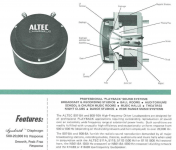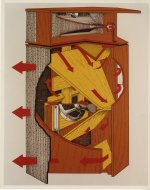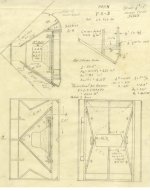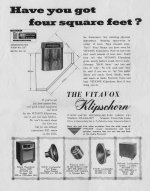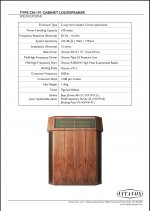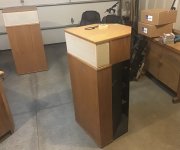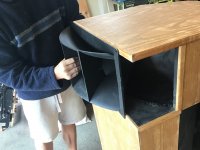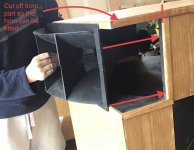Member
Joined 2009
Paid Member
(please move this thread to the new Horns forum when possible  )
)
It's a K-horn, which is short for Korner horn or Klipsch Horn depending on who you ask. The original was designed and produced by Paul Klipsch around 1946 and the rest, as they say, is history. https://www.klipsch.ca/blog/klipsch-down-low-horn-speakers
The design was licensed by the British company Vitavox and 20+years ago plans derived from the Vitavox version found their way to Ontario where various models were produced (and I know of an enthusiast who's still active and who helped build the boxes that now sit in my basement).
They are capable of good imaging so one need not be afraid of corner-situated speakers: https://www.diyaudio.com/community/threads/corner-horn-imaging-faq.248444/
I'm going to approach this from a FAST/WAW perspective with an Altec 511B metal horn providing the critical range of frequencies rather like a full range driver would in some of the popular FAST/WAS projects in the Full Range forum here. The driver on my 511B horn is the Altec 808-8a CD.
The box defines the woofer horn, so the only part left to play with will be the X-over and here there are many opinions.
FYI - I had originally turned down the opportunity to re-store these speakers after realizing it was boxes only with no drivers or metal horn and they are darn heavy but I was told that they sounded very good. Stereophile has this to say about the modern version "No one with a taste for realistic playback, and especially no one with a taste for low-power amps and high-sensitivity speakers, should miss a chance to hear these." https://www.stereophile.com/content/klipsch-klipschorn-ak6-loudspeaker
It's a K-horn, which is short for Korner horn or Klipsch Horn depending on who you ask. The original was designed and produced by Paul Klipsch around 1946 and the rest, as they say, is history. https://www.klipsch.ca/blog/klipsch-down-low-horn-speakers
The design was licensed by the British company Vitavox and 20+years ago plans derived from the Vitavox version found their way to Ontario where various models were produced (and I know of an enthusiast who's still active and who helped build the boxes that now sit in my basement).
They are capable of good imaging so one need not be afraid of corner-situated speakers: https://www.diyaudio.com/community/threads/corner-horn-imaging-faq.248444/
I'm going to approach this from a FAST/WAW perspective with an Altec 511B metal horn providing the critical range of frequencies rather like a full range driver would in some of the popular FAST/WAS projects in the Full Range forum here. The driver on my 511B horn is the Altec 808-8a CD.
The box defines the woofer horn, so the only part left to play with will be the X-over and here there are many opinions.
FYI - I had originally turned down the opportunity to re-store these speakers after realizing it was boxes only with no drivers or metal horn and they are darn heavy but I was told that they sounded very good. Stereophile has this to say about the modern version "No one with a taste for realistic playback, and especially no one with a taste for low-power amps and high-sensitivity speakers, should miss a chance to hear these." https://www.stereophile.com/content/klipsch-klipschorn-ak6-loudspeaker
Attachments
Last edited:
I wonder what would happen if you took off the backcaps, so the diaphragm sound could squirt out the back as well? Will you really be playing them at concert PA levels, such that the diaphragm needs a little something to push against, so it doesnt fly apart?
I always wondered about the little hunk of fiberglass absorber they stuck in there, in the same way that some old dome tweeters have a little hunk of felt cemented to the pole piece behind the dome. There's gotta be a lot of sound within that metal end cap that's just dyin' to get out. I assume it'll find its way back through the diaphragm itself, given enough energy.
I always wondered about the little hunk of fiberglass absorber they stuck in there, in the same way that some old dome tweeters have a little hunk of felt cemented to the pole piece behind the dome. There's gotta be a lot of sound within that metal end cap that's just dyin' to get out. I assume it'll find its way back through the diaphragm itself, given enough energy.
FYI/FWIW/YMMV:
The Symbiotik diaphragm is 'harsh'/'sharp' compared to the alum., so not HIFI and if replacing, recommend using GPA's listed for the 802E [34647].
These drivers are reactance annulled w/o the rear cap, which is strictly for diaphragm protection and if there's an inner black Bakelite loading cap, then it's also to dramatically reduce excursion, forcing a shifting up and/or increasing the XO point, so leave them off and the LF power handling is reduced plus if not in a box will comb filter with the horn's output [increased 'ripple' down low where you don't want it].
Loading cap's impact on the 604E's design/performance, so basically applicable for mating to other drivers/XO points: https://greatplainsaudio.com/gpa-vi...lansing-compression-driver-rear-loading-caps/
At the 'HIFI' levels I often used the distortion/damage to the diaphragm is assured [wish I'd taken a picture of some that had a 'perfect' indented phase plug impression ]. For apartments, etc., it may be OK depending on the horn's loading, XO point/slope.
]. For apartments, etc., it may be OK depending on the horn's loading, XO point/slope.
For OB, the [few] folks I'm aware of have historically used two matching, or one wide range, one [super] tweeter horns.
Same reason as the tweeter, i.e. to quell its cavity resonances since that space is basically a large IB one and to some can be quite audible when amplified by a compression horn.
As for rear output, my 'adventures' in [BL] horn design was a compound one using a discarded for scrap RCA compression driver, eventually with great success for its intended ~75 - 1000 Hz/-F12 BW and can't think of a reason why the Altec's would be much, if an, different since both were basically designed around the W.E. designs plus MGM's Shearer horn project.
The Symbiotik diaphragm is 'harsh'/'sharp' compared to the alum., so not HIFI and if replacing, recommend using GPA's listed for the 802E [34647].
These drivers are reactance annulled w/o the rear cap, which is strictly for diaphragm protection and if there's an inner black Bakelite loading cap, then it's also to dramatically reduce excursion, forcing a shifting up and/or increasing the XO point, so leave them off and the LF power handling is reduced plus if not in a box will comb filter with the horn's output [increased 'ripple' down low where you don't want it].
Loading cap's impact on the 604E's design/performance, so basically applicable for mating to other drivers/XO points: https://greatplainsaudio.com/gpa-vi...lansing-compression-driver-rear-loading-caps/
At the 'HIFI' levels I often used the distortion/damage to the diaphragm is assured [wish I'd taken a picture of some that had a 'perfect' indented phase plug impression
 ]. For apartments, etc., it may be OK depending on the horn's loading, XO point/slope.
]. For apartments, etc., it may be OK depending on the horn's loading, XO point/slope.For OB, the [few] folks I'm aware of have historically used two matching, or one wide range, one [super] tweeter horns.
Same reason as the tweeter, i.e. to quell its cavity resonances since that space is basically a large IB one and to some can be quite audible when amplified by a compression horn.
As for rear output, my 'adventures' in [BL] horn design was a compound one using a discarded for scrap RCA compression driver, eventually with great success for its intended ~75 - 1000 Hz/-F12 BW and can't think of a reason why the Altec's would be much, if an, different since both were basically designed around the W.E. designs plus MGM's Shearer horn project.
You will probably mount of a horn, but the speaker still only has horns covering about 4 octaves max, so it will mostly be a direct radiator.the new Horns forum when possible)
dave
Member
Joined 2009
Paid Member
GM, so you drove them loud enough to imprint the diaphragm! Jeeez, you must have gone deaf?
I’ve no direct experience with this simbiotik diaphragm. I contacted Great Plains Audio about an Al replacement. They advised me not to change out the Simbiotik before listening to them. I also found this comment from somebody who has heard them,
Altec aficionados may have been hasty and/or unkind in their initial reception of the Symbiotik. Even if the Symbiotik Altec aficionados may have been hasty and/or unkind in their initial reception of the Symbiotik. Even if the Symbiotik rolls off earlier than its aluminum brethren, it still reproduces proper harmonic overtones. It sounds very sweet, airy and open, with none of the smearing and compression I hear from the Asian clones. A Symbiotik equipped 802/808 sounds more organic than its descendants from Emilar and Renkus-Heinz. To my ears, the Symbiotic diaphragm has a niche in Hi-Fi and may well be the antidote to those who find the aluminum diaphragm a bit aggressive. off earlier than its aluminum brethren, it still reproduces proper harmonic overtones. It sounds very sweet, airy and open, with none of the smearing and compression I hear from the Asian clones. A Symbiotik equipped 802/808 sounds more organic than its descendants from Emilar and Renkus-Heinz. To my ears, the Symbiotic diaphragm has a niche in Hi-Fi and may well be the antidote to those who find the aluminum diaphragm a bit aggressive.
https://jelabs.blogspot.com/2017/03/altec-small-format-diaphragms-aluminum.html
Dave, I’ll leave you to tell the Khorn folk they have direct radiators….
I’ve no direct experience with this simbiotik diaphragm. I contacted Great Plains Audio about an Al replacement. They advised me not to change out the Simbiotik before listening to them. I also found this comment from somebody who has heard them,
Altec aficionados may have been hasty and/or unkind in their initial reception of the Symbiotik. Even if the Symbiotik Altec aficionados may have been hasty and/or unkind in their initial reception of the Symbiotik. Even if the Symbiotik rolls off earlier than its aluminum brethren, it still reproduces proper harmonic overtones. It sounds very sweet, airy and open, with none of the smearing and compression I hear from the Asian clones. A Symbiotik equipped 802/808 sounds more organic than its descendants from Emilar and Renkus-Heinz. To my ears, the Symbiotic diaphragm has a niche in Hi-Fi and may well be the antidote to those who find the aluminum diaphragm a bit aggressive. off earlier than its aluminum brethren, it still reproduces proper harmonic overtones. It sounds very sweet, airy and open, with none of the smearing and compression I hear from the Asian clones. A Symbiotik equipped 802/808 sounds more organic than its descendants from Emilar and Renkus-Heinz. To my ears, the Symbiotic diaphragm has a niche in Hi-Fi and may well be the antidote to those who find the aluminum diaphragm a bit aggressive.
https://jelabs.blogspot.com/2017/03/altec-small-format-diaphragms-aluminum.html
Dave, I’ll leave you to tell the Khorn folk they have direct radiators….
No, not really, just the typical experience I'd get at the Atlanta Symphony or typical rock concert at the 'fabulous' Fox Theater [FFT] or at the local in-town Church's low B pipe organ. 'Loud' would have been Deep Purple, Ted Nugent and a few others at the [FFT] where I repeatedly had to retreat to the Lobby and even with its somewhat soundproof doors was louder than most anyone would play their HIFI.
Anyway, at the time I had some little/no compression live recordings that I now know had 'fast' transients that were up to +40 dB, so never noticed them till the 'crack'/'pop'/'click' of grenade'd VCs.
The real 'bugaboo' though was I 'assumed' that with > 112 dB/w/m speakers/channel [in room, true corner loading] coupled to a McIntosh MC2500 I had no worries from either dynamics and/or amp distortion/clipping.
A real bummer since they were the very rare [for consumer sales] 'ultralight' developed for the 604E [34852] with solid output out to at least 22 kHz Vs the aluminum's ~nose dive up high. It's my understanding though that GPA's alum. replacement [26421] mirrors its performance plus higher power handling, but have yet to personally confirm either.
Anyway, at the time I had some little/no compression live recordings that I now know had 'fast' transients that were up to +40 dB, so never noticed them till the 'crack'/'pop'/'click' of grenade'd VCs.
The real 'bugaboo' though was I 'assumed' that with > 112 dB/w/m speakers/channel [in room, true corner loading] coupled to a McIntosh MC2500 I had no worries from either dynamics and/or amp distortion/clipping.
A real bummer since they were the very rare [for consumer sales] 'ultralight' developed for the 604E [34852] with solid output out to at least 22 kHz Vs the aluminum's ~nose dive up high. It's my understanding though that GPA's alum. replacement [26421] mirrors its performance plus higher power handling, but have yet to personally confirm either.
Historically, phenolic diaphragms most accurately reproduce the ~ 200 - 4500 Hz conversational, PA BW and the Symbiotik was TTBOMK originally designed to replace it in the new large format 291 series, small format 802G 'Tangerine' phase plugs for M.I. prosound apps, so by design has higher power, more limited HF BW than the alum, Pascalite 'consumer', studio, etc., monitor apps.
As such, it's designed to 'cut through' ambient noise over distance, so may very well outperform many/all period correct, or even some more current, competitors, but 'it is what it is' and that's all it is, so no doubt depending on myriad variables there's going to be folks that like/love them, but to date, the only ones I've known have a background in its intended app.
HIFI wise, Altec chose to use it in the 873A Barcelona, a 'new' 'Flagship' consumer speaker based on its 'breaking ground' new 9846-8A studio monitor, both a ~ monumental flop TTBOMK, though both were excellent, ~ competitively priced, products to the point where some 9846's wound up in HIFI apps, usually on DIY'ed matching box stands as a 'poor man's Barcelona and at one time a popular 500 Hz/511 DIY based design.
As such, personally would prefer them if a [super] tweeter is capped off at ~ 5000 Hz and have on occasion recommended it, though don't recall anyone ever giving any feedback, but otherwise. thanks, but no thanks.
As for 'aggressive' Altec alum. diaphragms; yes, if used in typical 500 Hz/2nd order XO designs at high SPL they can become 'strident' as it reaches its excursion limit like any driver, so early on I learned to use a 3/2 order to both ameliorate it and provide a much more time coherent response Vs Altec's doing the traditional reversing polarity of the horn and later, extending the horn mouth to load it down enough, same as Heathkit did with its HH-1-C Legato, while others upped the XO from 700 - 1200 Hz and Altec even switched to 800 - 1200 Hz for their prosound products as woofer power increased before cancelling the whole 'vintage' line in the '90s.
In short, use a product in its intended app and well within its design limitations for best overall performance.
As such, it's designed to 'cut through' ambient noise over distance, so may very well outperform many/all period correct, or even some more current, competitors, but 'it is what it is' and that's all it is, so no doubt depending on myriad variables there's going to be folks that like/love them, but to date, the only ones I've known have a background in its intended app.
HIFI wise, Altec chose to use it in the 873A Barcelona, a 'new' 'Flagship' consumer speaker based on its 'breaking ground' new 9846-8A studio monitor, both a ~ monumental flop TTBOMK, though both were excellent, ~ competitively priced, products to the point where some 9846's wound up in HIFI apps, usually on DIY'ed matching box stands as a 'poor man's Barcelona and at one time a popular 500 Hz/511 DIY based design.
As such, personally would prefer them if a [super] tweeter is capped off at ~ 5000 Hz and have on occasion recommended it, though don't recall anyone ever giving any feedback, but otherwise. thanks, but no thanks.
As for 'aggressive' Altec alum. diaphragms; yes, if used in typical 500 Hz/2nd order XO designs at high SPL they can become 'strident' as it reaches its excursion limit like any driver, so early on I learned to use a 3/2 order to both ameliorate it and provide a much more time coherent response Vs Altec's doing the traditional reversing polarity of the horn and later, extending the horn mouth to load it down enough, same as Heathkit did with its HH-1-C Legato, while others upped the XO from 700 - 1200 Hz and Altec even switched to 800 - 1200 Hz for their prosound products as woofer power increased before cancelling the whole 'vintage' line in the '90s.
In short, use a product in its intended app and well within its design limitations for best overall performance.
Point source drivers take ~90 deg of phase rotation to 'gather up its skirts'/'get going' whereas a compression horn is ~ instantaneous, so 2nd order on the woofer and 3rd order on the horn to delay it 'close enough' to the woofer.
That, or physically set back the horn to get it as Heathkit did.
That, or physically set back the horn to get it as Heathkit did.
Last edited:
Member
Joined 2009
Paid Member
Member
Joined 2009
Paid Member
Member
Joined 2009
Paid Member
OK - I hooked up the left-hand speaker for a first listen, using my TGM8 amplifier. I have to say that it was really interesting to have such an iconic driver in my home, no idea what the history of this particular unit is but I understand from the seller that it was in active use until about a decade ago. I don't know what the phasing is, there's no '+' that I can see on the terminals. I took off the rear cover and there is a green wire and a brown wire so I made the assumption that these represent '-' and '+' respectively. The sound has an ease and a clarity that made it feel as if the voice was 'in the room' and that's not something I get from my other speakers that easily. Initial impression at least is positive and encourages me to invest in this set up.
There's a bit of history to the enclosures. They were a clone of the Vitavox version of the K-horn built by a pair of lads in the 1980's. The original owner sadly passed away and I was able to secure the enclosures. A relative had been given access to remove all the drivers and the metal horn from the top so what I got was the wooden boxes and some 'torn holes' where a couple of screws were pried out (the original woofers had been partly glued in place with hot-glue anyhow).
There's a bit of history to the enclosures. They were a clone of the Vitavox version of the K-horn built by a pair of lads in the 1980's. The original owner sadly passed away and I was able to secure the enclosures. A relative had been given access to remove all the drivers and the metal horn from the top so what I got was the wooden boxes and some 'torn holes' where a couple of screws were pried out (the original woofers had been partly glued in place with hot-glue anyhow).
FWIW, historically the colors/phasing [pgs 13, 14]: http://www.lansingheritage.org/html/altec/plans/1974-enc-manual.htm
Member
Joined 2009
Paid Member
Member
Joined 2009
Paid Member
Member
Joined 2009
Paid Member
The original woofer was apparently a 416, which aren't exactly low cost these days. I decided I didn't want to invest in GPA new drivers so I bought some Eminence Kappa drivers from a local shop. I suspect they cost me no more than the shipping would have cost for GPA drivers. Call me a cheapskate but the metal squawkers cost me a lot more...
The speakers I obtained apparently sported Altec 511B + 806(?) when built, but I got just the empty boxes.
I bought a pair of Altec 511B horns (with the 808's) off ePay and to my dismay they do NOT fit the top box. I contacted the surviving member of the pair of lads who built these back in the 80's and he tells me that they 'cast their own horns' using a mold from an original. Their home-cast 511B's didn't incorporate the full sized flange so their version of the 511B was smaller and they didn't build the top box large enough for an OEM horn.
The damn horns don't fit the box!!
The speakers I obtained apparently sported Altec 511B + 806(?) when built, but I got just the empty boxes.
I bought a pair of Altec 511B horns (with the 808's) off ePay and to my dismay they do NOT fit the top box. I contacted the surviving member of the pair of lads who built these back in the 80's and he tells me that they 'cast their own horns' using a mold from an original. Their home-cast 511B's didn't incorporate the full sized flange so their version of the 511B was smaller and they didn't build the top box large enough for an OEM horn.
The damn horns don't fit the box!!
Attachments
Last edited:
- Home
- Loudspeakers
- Multi-Way
- The legendary K-Horn using altec 511B and 808-8a
